#even if we time MC back to be modern it would still theoretically be after HP the main series
Note
Ooooo I love your responses! I personally prefer numbers just because it’s easier for me to remember but I do respect noxcrew’s decision to make the event less sweaty lol. I realised after I sent the ask you had a post about missing buildmart (the beloved).
The question about players like Sapnap came as the reddit had a small discussion on if he would return. Most people agree that there’s no reason for why he can’t play unlike certain people (cough cough Punz) but if he does return that’s a different question. He doesn’t have many close friends who play regularly, he hasn’t been playing minecraft since Punz and George were called out and it’s well known that Sapnap is hard to put into a team. He can’t be PG, he only wants to play with some friends and Scott himself said that Sapnap is hard to put into a team because of said reasons. But I wanted to see an opinion outside of reddit lol.
Anyway more questions:
1, what do you think the new game is?
2, how do you feel about people claiming that the event is better because lots of ex dsmp members aren’t playing as much? Not counting the ones who were called out for horrible things, just former dsmp members not playing Eg, Philza, Tommyinnit, Foolish (Which is a wild take as Hbomb and CPK are ex-dsmp players and 3/4 of blue this mcc were so…)
3, what’s better, the new or old parkour warrior?
4, do you think someone in modern mcc could break Techno’s coin record?
5, the most difficult question yet, because Joel was playing mcc before becoming a hermit, should Hbomb have to play with Joel again to add him to his hermit list or do we add Joel to H’s hermit list without them playing together again?
That's a fair point about numbers, but for me I actually feel like most of the mccs in the late 20s/30s sort of blend together for me? although that could just be how season 3 was
Yeah, those are all also good reasons why he wouldn't. I could see trying to bring him back for like, hype/views, but I hadn't thought about how many of his viable teammates have quit the event LMAO. Probably for the best with the way noxcrew is trying to make things less competitive anyways. If nothing else I will miss having someone to root against, I guess
New questions :D thanks!!
for 1) i have absolutely NO idea. I REALLY hope its a team game, a redstone game would be fun but there's no way they actually would do that so. eh. Maybe something with players on different tracks going through a puzzle course, kind of like that one grid runners room with the pistons? Seems like minecarts are involved, anyways. I'd love to hear any theories you have!
2) People are saying that? that's dumb, lmao. I'm glad to see dt leave, but beyond them? Most of the dsmp crew were great sports and I think one of the best parts of mcc was getting to see different communities interact! I mean, a lot of them are moving past mc as a whole and mcc *has* been running for a very long time now, so I don't blame them for leaving, but I am sad to see them go. Although making room for newcomers is great too, and I love the variety of players we're seeing already for s4
3) new 100% old pkw SUCKED. it wasn't even fun to watch the good players, honestly. I hate old pkw but new pkw is actually really enjoyable! Lot more strategy, a lot more room for players to not feel like deadweight. still not my favorite game but it is honestly one of my favorite movement games
4) I mean, it's theoretically possible, but I don't think it'll ever happen. I mean it's been ages since someone's even broken 4k. I also just don't think we'll see a game lineup with the most high-scoring games, it'd make for a pretty unbalanced roster with basically no team games and that's no fun! but 4k maybe, especially if sg ever returns and the new game is point heavy.
5) woah, heavy hitter. I hadn't thought of that... I wanna say it should count. joel's always been so hermit adjacent anyways, so actually I'm checking now and they haven't teamed since SEASON 1???? No it doesn't count. solely because they should team again
3 notes
·
View notes
Note
burner house opinions please agree or disagree: mike is the hufflepuffest hufflepuff to ever huff a puff. texas is so gryffindor he poops baby lions. julie is a slytherin and hates it but she is better at it then anyone else. chuck and dutch are very different ravenclaws and have very different answers to the common room riddles. HOUSE SOLIDARITY TEAM.
HHHHHH OKAY might as well answer this one right after the other one. This one is rough because I can usually find a reason any given character would be in at least three of the four houses???? Uh....but let’s see, lemme think about it.
......Well I don’t want to repeat myself from my previous post, but Texas is pretty easy. He would INSIST on being Gryffindor. He would throw the biggest shitfit if he WASN’T a Gryffindor. He’d inevitably end up in Gryffindor. As for the others...
Mike could be Hufflepuff for sure, but he’d also make a pretty damn solid Gryffindor. Boldness, courage, charging in without thinking to help people, he does definitely tick the boxes. I’d actually lean slightly more toward Gryffindor? He’s got the loyal, kind, dedicated part down, but I mean...”daring, nerve and chivalry” is pretty solidly Mike too. His defining trait is thoughtless bravery and a reckless desire to do good, and that reads to me as a Gryffindor.
Julie would make a very solid Slytherin, I gotta agree with you on that one. Determined, ambitious, cautious but also daring when it counts...and a tendency to make friends and do whatever the hell she needs to to keep herself and her friends on top. *bangs gavel* SOLD.
Alternate left field theory though: Julie “this isn’t fair, i need to fix it” Kane, Julie “I’d do the right thing even if it means hurting myself and working against my father” Kane, goes to hogwarts and gets sorted into fukkin Hufflepuff????!?! Spends the entire story lying to her dad and saying she got into Slytherin. The strangest Hufflepuff/Slytherin personality combo.
Chuck.....hhhhh, okay, he’s the weird one for me. Ravenclaw is probably where he would be happiest, for sure. If I was writing this as a story though, I would sort Mike into Gryffindor and I would very much consider that tiny, 11-year-old Chuck, wanting desperately to be brave, would follow Mike into Gryffindor as well. That would fit nicely with his plotline about not feeling brave enough to be in the Burners, and how the real nature of his courage is being terrified but going FUCK IT I’M RIDE OR DIE! and plunging in headfirst anyway.
..............that previous sentence is also why a distant third possibility is Chuck the long-suffering Hufflepuff, loyal to his friends to the detriment of his own mental health, brave because he’s gotta help, not for bravery’s sake.
I’m getting distracted.
Dutch’s literal entire dish is being a free-thinker and doing shit his own way, so yeaaahhhhh, that’s Raveclaw pretty well pegged. I would love to see Dutch making spells up and doing wild shit and none of the teachers knowing what to do with him, it would be great.
It’s probably not a coincidence that my fav. character is the one I’m most like “ehhh, WELL.........” on, but hey, you gotta follow ur heart, right.
Alernate version: they all go to some kind of American magic school in the middle of Detroit. Hogwarts houses are some kind of weird elitist British thing and/or OUR CITY NOW, MAKE UP THE HOUSES, HELL YES.
.........anyway, there’s some thoughts, do what you will with them.
#Motorcity#Harry Potter#I'm really interested by that secondary Julie plotline#and also by the fact that they would be American transfers into a British boarding school#which is absolutely fascinating to me haha#I've always loved HP crossovers where people acknowledge language or culture barriers when they cross over#Further concern: when is this set because the HP series happened like in the nineties or whatever???#even if we time MC back to be modern it would still theoretically be after HP the main series#....................these are the kinds of things I think about when somebody suggests a low-key low-stress crossover concept to me haha#Anonymous
45 notes
·
View notes
Text
I wanna talk about Janet Drake
I’m not against exaggeratedly evil versions of Tim’s parents, tbh. It’s fanfiction, if we can depict an Exaggeratedly Good version of Bruce (which we can, and I do, and I love) then we can depict the Drakes as Exaggeratedly Bad. As someone who personally identifies with Tim, and his brand of complicated parental abuse in particular, I find it cathartic to uncomplicate that abuse and rescue him from the Obviously Evil Bad People.
That said, since much of comics lore is passed down word of mouth, the oral tradition surrounding Tim has developed this idea of Janet as The Worse Parent between her and Jack that was never really present in the comics. We see much LESS of Janet, and we have 20 years worth of comics depicting Jack as a neglectful hotheaded idiot who ultimate does love his son. More importantly, Jack isn’t very much LIKE Tim, so there is a habit to attribute Tim’s traits to his mother... and, as someone who really really identifies with Tim, Tim has... some negative traits. Tim can be a bitch sometimes. He’s fiercely intelligent and sweet and kind, with a strong sense of justice, but he can be cold and judgmental and unthinking - he fights those traits, but he does have them.
And it is perfectly fine to depict Janet that way. I’ve enjoyed depictions of Cold Calculating Janet Drake, but it’s not the ONLY option, and I want to challenge fans to consider different avenues. Tim could pick up these traits from anywhere: a nanny, Mrs. Mc Ilvaine (”Mrs. Mac”), a teacher, tv, Sherlock Holmes novels, Bruce Wayne himself. Tim is capable of not being like EITHER parent.
So, what do we KNOW about Janet? (I’ll also touch on Jack, but only in scenes he appears with Janet.)
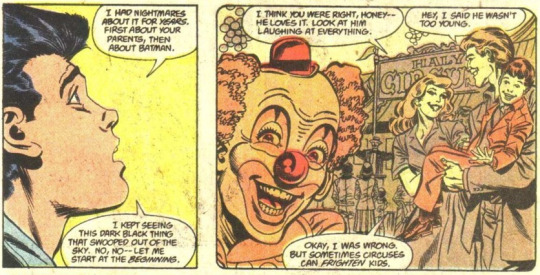



When Janet was first introduced she was depicted as a gentle but “modern” woman. This was written in 1989, told by a 13 year old Tim, so this theoretically was meant to take place in 1979. I’m not here to give a lecture on the history of sex discrimination in the united states, but much of the legislation protecting women in the workforce or surrounding women’s bodily autonomy would have been very very new in this initial depiction.
Here, Janet is shown to be encouraging, emotional, maternal, and projects her own feelings onto Tim. Jack is shown to be slightly sexist, possibly discouraging, but not overbearing. And the artist is shown not to know how to draw children.
To insert some speculation, I think it’s important to note all the Drakes witnessed a terrible murder/accident that day. I point this out, because this is the last time Jack and Janet are depicted this way. It’s possible they changed as a result of this event specifically.
However, this is also a story being told by Tim. It’s also possible these events aren’t really “real” at all, and Tim is misremembering what his parents were like as a three-year-old, possibly projecting a more palatable version of his parents into the narrative. This is entirely up to personal interpretation.
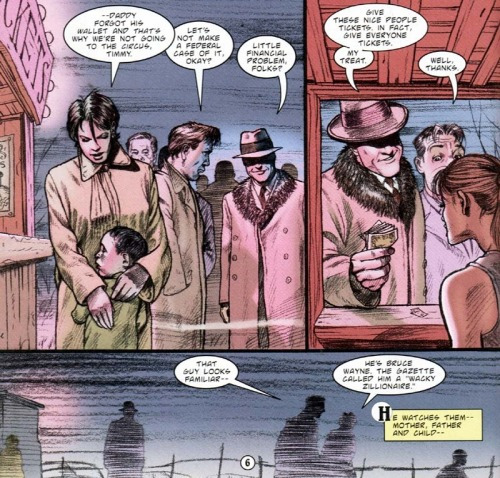
In fact, the Drakes are shown in Legend of the Dark Knight attending Haly’s Circus, and the artist knows what a toddler looks like and they’re depicted as already having a slightly strained relationship. Jack is clearly on the defensive, and Janet seems to be passive-aggressive, though she could just be attempting to explain the situation to her toddler honestly. The intended tone isn’t especially clear.
I do want to point out, in this depiction, Tim isn’t being carried like he was in the previous one. He’s walking ahead of his parents, which isn’t a terrible horrible crime, but could be dangerous in a crowded place like the circus. Might be a subtle hint to his parents overall neglect.
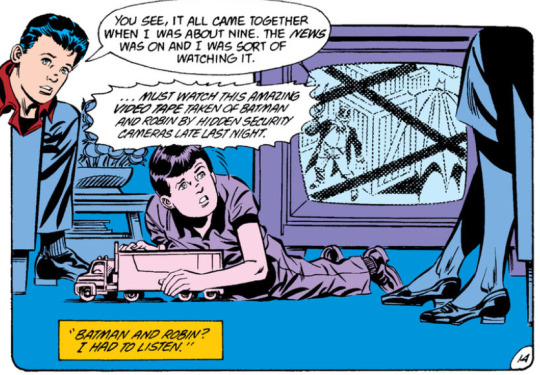
Back to A Lonely Place of Dying, in Tim’s memories of the night he discovered Robin and Dick Grayson were the same person at nine-years-old, his parents are home, and watching TV together while Tim played... trucks, idk, in the living room with them. (This is semi-interesting, because you could say “oh, Tim liked vehicle toys as a kid” or you could extrapolate that this is another subtle indication of Jack’s sexism, providing Tim with appropriately “boy toys.” Either interpretation is valid. If Tim was assigned female at birth, would they have been given “girl toys,” or allowed to play with whatever they wanted?)
This is, to my knowledge, the only panel of the Drakes when Tim is between ages 3 and 13. They’re all together, which might indicate that the Drakes were home more often when Tim was 9, only later going on business trips when Tim was “old enough” but...

This is Tim’s boarding school when he’s 13. While most boarding schools in the US are for grades 9-12, Tim is clearly not a freshman at age 13; look how much younger the other kids in this panel are. In the US, the youngest you can attend most boarding schools is 7.
That means Tim could have begun going to boarding school anytime between 7 and 13. He most likely spent all of middle school in boarding school, at least. There are an almost infinite number of possible ways the Drakes handled having a business that required lots of international travel, an archeology hobby, AND a very young child. Janet staying home until Tim was 7, 11, 13, is equally possible as the Drakes having a nanny until 7, 11, 13. Tim just doesn’t talk about that period of his life very much.
(”What about Mrs. Mac?” - it is unclear when Mrs. Mac begins working for the Drakes. We only see her when Jack comes out of his coma. She could either be a long standing staff member, or a recent hire.)
Note: I’ve seen it said that it’s canon that “According to Tim, when his parents were home, they made a point to try and include him in their activities, bringing him along to events that were normally adults only.” I have never seen this panel, or I don’t remember it, so I cannot confirm, but I also cannot debunk this because... comics.


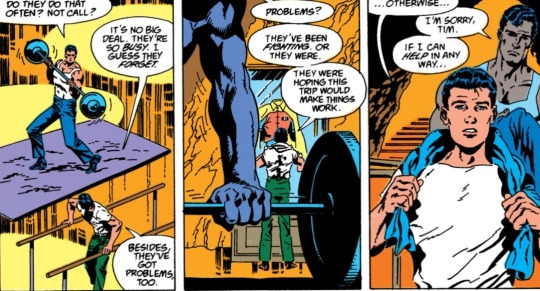



By the time Tim is 13, Jack and Janet are away on business trips a lot, with limited communication, and no firm return date. If I’m feeling generous, I’d say it was harder to communicate internationally in 1990 than it is today. If I’m not feeling generous, I’d say the Drakes are extremely wealthy, and international communication was easier than ever before in the 80s and 90s. They’re not even going home to see Tim in a week or two, they’re going home and calling Tim at boarding school in a week or two.
Even Bruce thinks its weird, though he doesn’t say so to Tim’s face. It’s written almost as if Tim’s parents’ neglect was meant to be a plot point that just got forgotten about.

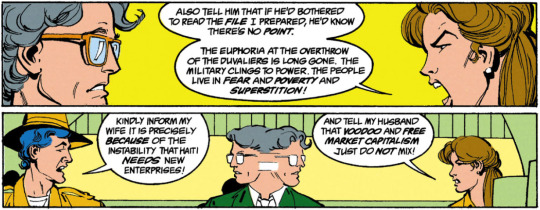

Tim’s parents are fighting at this point (their poor assistant), but Janet still goes with Jack on these business trips. And she’s clearly involved in the business, somehow, but the comics never SAY what Janet’s JOB is. We’re told Jack is the exec, but Janet is ONLY ever referred to as Jack’s wife, though they’re later described as the “heads” of the company, plural.
Just to be clear, this is Jack’s business. There’s a perception that Jack is a bad business man because he and Janet fight over company decisions, and Jack looses the business after Janet dies, but Jack looses the company YEARS after Janet dies, and maintains it for about a year after No Man’s Land at that. We’re not told how Jack looses the business, but he’s got to be doing something right. Janet isn’t necessarily the “real brains” of Drake Industries.
And I’m not... gonna... touch the... exploitation and racism because... I’m not qualified to do that. But, here’s the panel. The Drakes sure seem exploitative and racist in their business decisions. Someone else can... analyze that with more nuance.
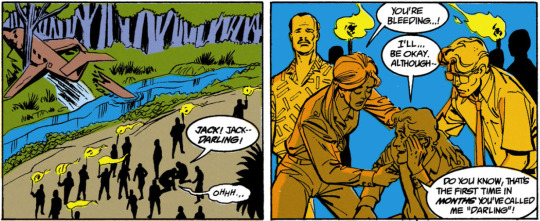
Regardless how how long they’ve been fighting, when their lives are in danger, the Drakes fall back into a loving husband and wife. Their marriage may be falling apart, but they do care about each other.


I want to show these panels because it shows that Tim and Jack do have things in common. They’re both level headed in a crisis and can be somewhat cold in their practicality. Janet meanwhile and silent. Jack is later willing rant and rave at their captors, but Janet remains silent.

That is, until they’re alone, and she finally lets herself fall apart.
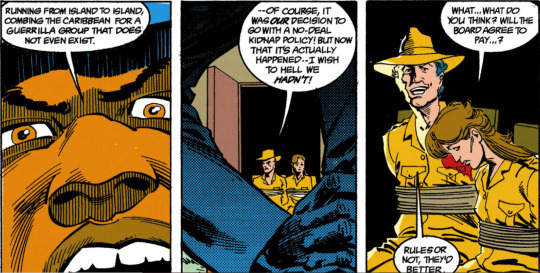

God, Jack can be obnoxious. Janet just looks miserable and resigned. I actually think Tim takes after his parents in this respect in equal measure. Tim can have a temper, but he can also be fairly melancholy and defeatist.
Jack keeps reminding Janet to be strong and in control, which could be period typical sexism? But Jack seems so practiced and ready with the words of encouragement, and with Tim’s history with depression, I wonder if Janet has an inclination towards it as well.
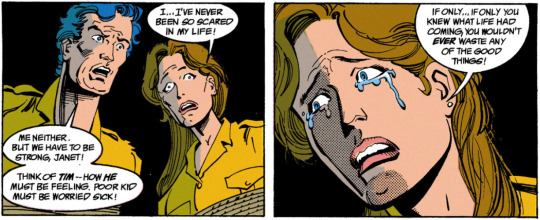
As the end approaches, when Jack brings up Tim, Janet seems to have a lot of regret. She talks about “wasting” the good things, and I don’t think it’s too big of a stretch to assume she’s talking about time spent with her only child.
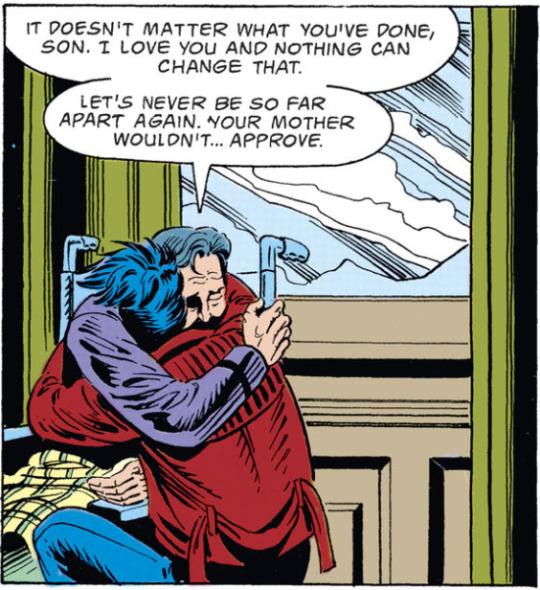
From this point on, Janet is at times spoken of, but not seen. Like here, when Jack says Janet wouldn’t approve of him and Tim being so “far apart.” He says this after he tells him he takes back his threat to send him back to boarding school, which might imply Janet was against the idea of boarding school? Though she obviously lost that argument when she was alive.
Jack will of course renege on this later, but that’s Jack Drake for you.

Or here in Tim’s illness induced dream, where he gets everything he wants. Though, since this is a fantasy of Tim’s, where his father and girlfriend are both more accepting and understanding than they are in real life, I would take this depiction of Janet with a grain of salt.
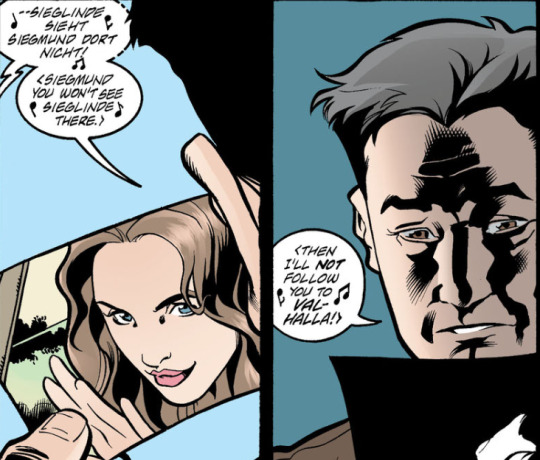
After loosing Drake Industries, Jack thinks about Janet (though, they call her Catherine/Cathy for some fucking reason) during his depressive episode. And... uh...

Hallucinates a Valkyrie???? Is this symbolic of suicidal thoughts, or is she... real? Or is he seriously hallucinating?

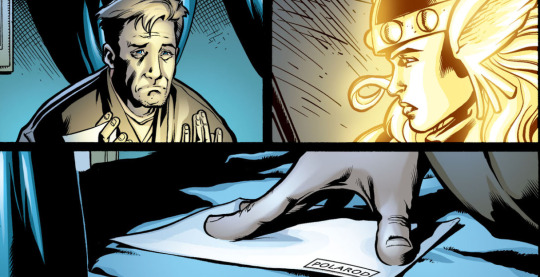
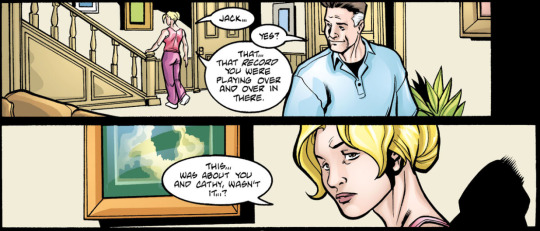
Anyway, we’re not here to discuss Jack’s mental state, the fact that he forgot Tim’s birthday, or that concerning “I was going to knock some sense into you but you’re still bigger than me” statement from Tim, we’re here to talk about Janet. And even though this entire arc is about Jack mourning his first wife, they don’t SAY anything about Janet herself at all. I mean, they don’t even get her name right, so I guess what was I expecting.
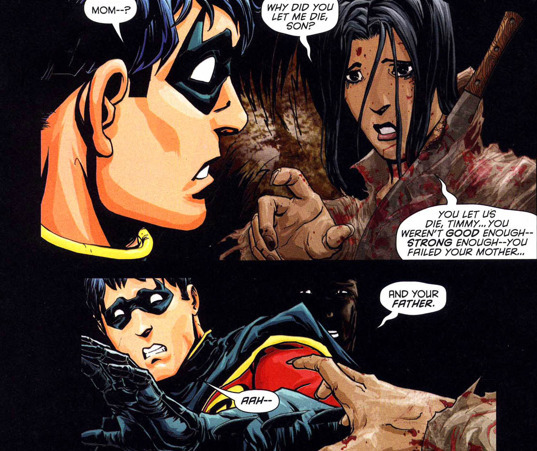
Then there’s Origins and Omens, which also doesn’t say anything about Janet, except that Tim’s memory of her is faulty - Janet was poisoned, her assistant Jeremy’s throat was slit on television, but Tim seems to have conflated the death he did see with the death he didn’t.
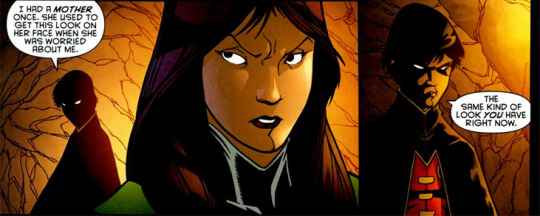
The only piece of canon to suggest that Janet might be cold, is Tim compares her to Thalia. And even then, he’s really just saying Janet was protective of him. It’s kind of a scary look to make at your kid, but Bruce does the same thing, so.
I do want to say... it’s not 100% clear if Tim is even talking about Janet. He could be talking about Dana. Dana was observably protective of Tim, though I don’t think he’s ever called her mom. He PROBABLY means Janet.
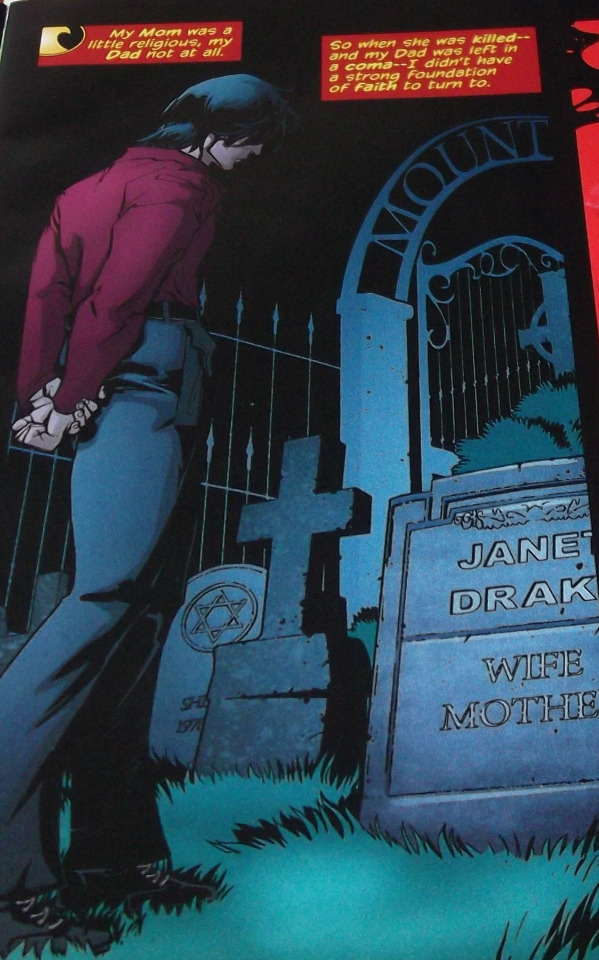
And finally we have Tim visiting his mother’s grave (in a duel Christian/Jewish cemetery, make of that what you will), where Tim says she was “a little religious.”
And that’s it! That is all we know about Janet Drake in New Earth. Hardly the Mom From Hell, but she isn’t perfect. I’d be interested in seeing some alternate depictions of her within the fandom.
I’m still gonna eat up Terrible Parents From Hell like a starving puppy dog, though. Just some food for creative thought.
1K notes
·
View notes
Text
Scientists Make Big Step Towards Making Antimatter Stand Still
https://sciencespies.com/news/scientists-make-big-step-towards-making-antimatter-stand-still/
Scientists Make Big Step Towards Making Antimatter Stand Still

One of the biggest mysteries of modern physics is the question of why we don’t see as much antimatter in the universe as ordinary matter. A possible explanation is that antimatter is simply different from ordinary matter in an unknown, but important, way. To explore this possibility, scientists have trapped antimatter to study its properties. However, making precise measurements on antimatter require that it be nearly stationary and that has been hard to do until now. Scientists working at the CERN laboratory in Europe have just announced that they have used lasers to slow the motion of antimatter, resulting in unprecedented capabilities to its properties.
Antimatter is a subatomic cousin of ordinary matter. Its existence was predicted in 1928 by British theoretical physicist Paul Dirac, and it was discovered in 1932 by American physicist Carl Anderson. For every known subatomic particle, there is an antimatter equivalent. The electron’s counterpart is the positron, identical in every way to the electron, but with the opposite electric charge. The antiproton and antineutron also exist, and were discovered in the 1950s at a particle accelerator located on a hill, high above the University of California at Berkeley.
Matter and antimatter don’t get along all that well. If you combine them, they annihilate each other in a huge burst of energy. On the subatomic level, this energy is manageable, but if one were to combine a gram of antimatter with a gram of matter, the result is an energy release comparable to the atomic explosion at Hiroshima. A gram is equivalent to the weight of a paperclip.
It’s this antagonistic relationship with matter that makes antimatter difficult to study. If an antimatter particle comes into contact with its matter equivalent, the two disappear in a subatomic flash of energy.

MEYRIN, SWITZERLAND – APRIL 19: A detailed view of in Antimatter Factory work area during a behind … [+] the scenes tour at CERN, the World’s Largest Particle Physics Laboratory on April 19, 2017 in Meyrin, Switzerland. The Antimatter Factory in CERN where physicists try to unlock the secrets of antimatter. There, we can find the Antiproton Decelerator (AD), a unique machine that produces low-energy antiprotons for studies of antimatter, and creates antiatoms. The AD produces antiproton beams and sends them to the different experiments. ELENA (Extra Low ENergy Antiproton) is a new deceleration ring that will soon be started. Coupled with the AD, this synchrotron, with a circumference of 30 metres, will slow the antiprotons even more, reducing their energy by a factor of 50, from 5.3 MeV to just 0.1 MeV. The antiprotons beams will be sent to the different experiments in the Antimatter Factory. The number of antiprotons that can be trapped will be increased by a factor of 10 to 100, improving the efficiency of the experiments and paving the way for new experiments. Currently, the AD serves several experiments that are studying antimatter and its properties: ALPHA, ASACUSA, ATRAP and BASE. Two other experiments, AEGIS and GBAR, are preparing to study the effects of gravity on antimatter. GBAR will be the first experiment to use antiprotons prepared by ELENA, the new decelerator. (Photo by Dean Mouhtaropoulos/Getty Images)
Getty Images
Scientists have been able to trap antimatter particles using a combination of electric and magnetic fields. Antiprotons have been stored for over a year, while antimatter electrons have been stored for shorter periods of time, due to their lower mass. In 2011, researchers at CERN announced that they had stored antihydrogen for over 1,000 seconds.
While scientists have been able to store and manipulate small quantities of antimatter, they have not been able to answer why antimatter is so rare in the universe. According to Einstein’s famous equation E = mc2, energy should convert into matter and antimatter in equal quantities. And, immediately after the Big Bang, there was a lot of energy. Accordingly, we should see as much antimatter as matter in our universe, and yet we don’t. This is a pressing unsolved mystery of modern physics.
According to Einstein’s equations, as well as other modern theories of antimatter, antimatter should be exactly the same as ordinary matter, with only the electric charges reversed. Thus, antimatter hydrogen should emit light just like ordinary hydrogen does, and with exactly the same wavelengths. In fact, an experiment showing exactly this behavior was reported in early 2020. This was a triumph for current theories, but meant no explanation for the universe’s preference of matter was found.
Because of the difficulty of storing antimatter, the light emission spectrum of antihydrogen was not as precise as the equivalent measurement using ordinary hydrogen. One of the key reasons is that it has not been possible to slow antihydrogen atoms down. When they are produced, they continue to move at velocities that are large enough to affect the precision of measurements.
So researchers affiliated with the Alpha experiment at CERN set out to slow down antihydrogen atoms. They made antiprotons in their accelerator and combined them with antimatter electrons coming from the decay of sodium-22. They then used lasers to slow down the resultant antihydrogen.

The Alpha experiment has successfully used lasers to cool antimatter hydrogen atoms.
CERN
The method is really quite clever. Ordinarily, if you hit an atom with a photon of enough energy to make the electron jump from a low energy state to a higher one, and then the atom decays back to the low energy state, the result is that the atom is in exactly the same state as it was before. Energy is conserved.
However, in laser cooling, researchers irradiate atoms with photons of an energy just below the amount required to make electrons jump from one state to another. If the atoms were stationary, no transitions would occur. However, if the atoms are moving, those atoms moving towards the light source will contribute some motion energy, so the energy of the atom and the energy photon is enough to make electrons jump between energy states.
The atom eventually decays, emitting a photon, but emitted photon will be the full energy of that atomic transition, while the absorbed photon will be slightly lower energy. Because the emitted energy is a little higher than the absorbed energy, the result is that the atom will have slightly lower energy after this process. Consequently, it will slow down.
When Alpha scientists aimed such a laser at antihydrogen atoms for several hours, they found that the resulting average velocity of the atoms was about 10% what they were at the outset. The temperature of these antihydrogen atoms became about 0.012 degrees Kelvin, or nearly absolute zero.
When the researchers tested the precision of light emitted by these cooled atoms, they found a fourfold improvement over earlier measurements.
This first use of lasers to cool antimatter atoms will have very real consequences for studying antimatter. Already, they have an improved measurement of the properties of light emitted by antihydrogen. These techniques will also help a great deal in their main research program, which it to study the effects of gravity on antimatter. Conventional wisdom suggests that antimatter should be affected by gravity in a manner identical to matter, but this has not yet been tested. First results of this very interesting measurement could be available in 2022.
The cooling of antimatter by lasers is a tremendous technical achievement and its value will only become more apparent over time.
#News
1 note
·
View note
Text
Random CS Fic Recs
@stunningswxn asked me for some recs for completed MCs. Here is a (non-exhaustive) list of stories I love.
(I’ve realised that I am Terrible at categorising fics, so this is only split into modern au/enchanted forest au/canon divergence. The super organised part of my brain is shrieking “not good enough!” the messy part is responding “whatevs”.)
Fics below the cut to save your dash.
I’ve put a * next to anything that gets smutty, in case you want to avoid/seek out the smut.
Modern AU
In the interests of ease I’ve split this into friends to lovers and other. I case it doesn’t become immediately apparent after this I am WEAK for that trope.
Friends to Lovers
Theoretically* by @this-too-too-sullied-flesh
This is everything I love about fanfic in one story - well written, on point characters in a modern setting. Witty dialogue, amazing supporting cast and there’s some pretty hot smut, which never hurts.
Lethologica* by @lifeinahole27
This is serious comfort reading for me. Reading how Emma and Killian’s relationship moves so seamlessly from friends to friends with benefits to Everything just makes my heart feel so happy.
What We Wouldn’t Do* by @sambethe
Apparently I’m not *just* weak for friends to lovers, I’m also weak for friends with benefits to lovers. I love this particular entry for the hot scenes but also the moments where you see just how close and how good friends they really are. It’s just like the best relationships should be: they’re best friends first and foremost, everything else is a bonus.
Lend Me Some Sugar, I Am Your Neighbor by @killians-dimples
Emma’s childhood friend Killian moves in next door and they fall back into an easy friendship. There are literally only two chapters, but I still found myself dying waiting for them to get together.
Other
Guilty, Your Honour* by @shipping-goggles
Even when a fic isn’t explicitly “friends to lovers” an element of that always creeps in to my favourite stories. What can I say? I’m a sucker for healthy, mature and supportive relationships. Anyway in this fic we see Emma and Killian develop an amazing friendship built on trust and mutual respect and that makes me so happy. Be prepared for some angsty moments thought, it’s not all smooth sailing for them!
(Just this week Kathi released a prequel to this The Laws of Attraction - so freaking good!)
Oh, Brother… by @the-captains-ayebrows
Liam’s fed up of Killian meddling with his love life, so his roommate Emma volunteers to pretend to be his girlfriend. This is such an awesome set up and it does not disappoint! Funny and awkward, Killian and Emma’s sizzling chemistry is undeniable and so compelling.
Can’t Erase Me* by @icapturedkindness
Emma can’t bring herself to tell her mum that she’s broken up with Killian so he agrees to pretend to still be dating and visit Storybrooke with her. The angst of Emma denying her feelings, being oblivious to his feelings and how they navigate around each other is heart breaking.
These next three are quite gritty and angsty, there’s some uncomfortable reading and moments that might make you cry, proceed with caution:
The Difficult Kind* by @nowforruin
Emma and Killian meet when they are both working undercover against the sadistic Gold. It’s so compelling how they move past their terrible first meeting and (assuming that you haven’t already read this) I am jealous that you get to binge read this all in one go as your first experience with the fic. Although I probably would have missed out on sleep to find out what happens next so it’s probably for the best.
The Darling Affair by @icecubelotr44
Technically this one doesn’t meet your criteria because it isn’t finished… But it will be any day now. Possibly even before I post this list! I figure by the time you trawl through the rest of the fics, this will be finished. Killian’s a special agent, Emma’s a social worker, they’re thrown together to save Michael Darling. Emma’s tenacious, Killian’s basically James Bond, it’s amazing.
Secrets and Spies, Truth and Lies by @nothingimpossibleonlyimprobable
And another spy fic - this time both Killian and Emma are secret agents. This is a dark and dramatic story with a helping of whump.
Enchanted Forest AU
So apparently I haven’t read enough enchanted forest fics - if anyone can point me in the direction of some exceptional fics, hook me up!
The Princess and the Apple Tree by @stubble-sandwich
A stunning fairytale that deserves to be a beautifully painted storybook - the fancy kind with gold leaf in the illustrations. It’s a short Lieutenant Duckling MC that will steal your soul.
Parley* by @amagicalship
Deckhand Killian meets feisty Captain Swan in this short and sweet sexy MC.
Canon Divergence
Roses in December by @justanotherwannabeclassic
This is pure poetry. I cannot get over the beauty of Shea’s writing in this story - and you get the added bonus of Daddy Killian to make you swoon.
Unbreakable* by @xemmaloveskillianx
You probably have read this already, it’s so popular, but in my opinion it deserves all the praise. Killian crosses the town line with Emma and Henry after Pan’s curse sends everyone back to the Enchanted Forest and what results is Epic.
Wednesday* by @madjm
Emma winds up in a Groundhog Day style scenario, re-living Wednesday over and over again. It’s really fascinating to see what she does when no one else can remember - it’ll break your heart in the best way possible.
Straight to You by @montanarosalie
“Emma would rather be cursed than lose Killian for good. And so they are.” Only Read this if you are ready for some serious pain, I think I started sobbing at like chapter 3 and the tears never stopped.
You Don’t Know Me, You Don’t Wear My Chains by @qqueenofhades
Part 1, Part 2, Part 3
Killian’s Henry’s dad. I bet you’re thinking “awww”, but no, you are in for a world of pain. You’ll love it.
Happy reading!
61 notes
·
View notes
Text
Edwin C. Hill, Jr., Aux armes et caetera! re-covering nation for cultural critique, 2 Volume! 115 (2003)
Résumé
Gainsbourg’s 1979 release Aux armes et cætera, an album entirely recorded in Kingston with legendary reggae musicians, takes French song where it had never geographically or musically gone before. In retrospect, we might be tempted to dismiss this cover of the French national anthem; after all, Gainsbourg had already borrowed other musical genres like jazz and disco. Yet, while Gainsbourg’s previous work had earned him recognition as a major innovator of French song somewhat because of his playful and provocative eccentricities, this song was met with a scathing, overtly anti-Semitic and nationalist backlash. Gainsbourg’s play with genres (national anthem, French song, and reggae) touched on sour spots of French identity. years later, Big Red recovers Gainsbourg’s cover of the national anthem on his release Big Redemption. While Gainsbourg only minimally alters the words of ‘La Marseillaise,’ letting the genre itself perform the critique, Big Red’s release remilitarizes and desexualizes the cover while inverting and re-inscribing the roles of revolutionary and oppressor in the contemporary dynamics of popular culture and postcoloniality. His recovery of the national anthem becomes a performance of the ‘empire singing back.’
Serge Gainsbourg’s album Aux armes et cætera (1979), entirely recorded in Kingston with legendary reggae musicians, takes French song where it had never geographically or musically gone before. Gainsbourg’s personal musical trajectory, his public persona, and his place in the history of French popular music may lead us to overlook the particular implications of this transatlantic collaboration. After all, by 1979 he had already successfully utilized jazz and disco as he would later use rap to push the boundaries of French popular music and to experiment with personal musical identity. However, while Gainsbourg’s previous work earned him recognition as an innovator of French song in part because of his playful and provocative eccentricities, the title track of this album, a reggae cover of the French national anthem, sparked public backlash. Gainsbourg’s play with genres crossed borders in ways that touched on socio-cultural sore spots and national anxieties within dominant narratives of French identity.
Twenty years later, francophone hip hop artists like Big Red, a former member of Raggasonic, turn the art of surprising national borders with new combinations of musical identity into a rule of cultural practice. With songs like ‘El Dia de los Muertos,’ a collaboration with La Cliqua’s MC Rocca, ‘1001 Nuits’ recorded with 113, and ‘Respect or Die’ from his solo album Big Redemption (1999), Big Red refutes any suggestion that today’s popular music is devoid of political content and ideological self-awareness. Vocal delivery, linguistic strategies, and artistic collaborations decenter official French and francophone identities by relocating them within the musical boundaries of the banlieue and the bled, boundaries extending beyond and cutting across those of the nation-state and the postcolony.
What follows from this transnational musical encounter? How specifically does this encounter resonate with cultural reception and the production of musical meaning? And what are the implications for discourses of power and protest in popular culture? In short, how do these two cover songs critique grand narratives of identity and live to tell ‘the half of the story that’s never been told’? I explore these questions through an imaginative and theoretical metaphor I am calling recovery, in order to propose hearing performance quotation and cover songs as musical interrogations of and recuperations from dominant narratives of identity. In this paper I argue that these musical recoveries of the ‘Marseillaise’ point up disjunctures between the histories of French universalism and imperial discourse on one hand and the reality of the postcolonial, postmodern condition on the other.6
Provocateur à la tête de chou
Serge Gainsbourg initially gained credibility as a great composer, if not so great singer, of chanson française. ‘Le Poinçonneur des Lilas’ (1958) typifies in many respects the established tradition of French song where wit and word play frame a psychological portrait of the quotidian. Here, Gainsbourg pays homage to the poinçonneur, a subway ticket puncher in the Paris metro. Haunted by the petits trous that seem destined to follow him everywhere, the poinçonneur contemplates shooting himself. Realizing that this would still be making petits trous, and that no matter how he dies he will be buried in a petit trou, he teeters on the brink of insanity. The song ends with him stuck between worlds, muttering “des petits trous, des petits trous, des petits trous.”
A slick up tempo jazz feel provides the narrative’s musical backdrop. The song depicts the daily travails of Parisian modernity in a genre strongly associated with (African) American musical culture; yet it is the French narrative, privileged by a lyrical, economic melody, that dictates the piece musically. The musicians’ tight playing, the sparse texture created through instrumentation (oboe, baritone sax, flute, piano, snare drum, and upright bass), and the closeness of the voice in the mix work with the text to produce the intimate feel characteristic of chanson française. The quick swing pattern of the brushes on the snare drum mimics the sound of the train moving down the tracks. The chromatic climbs and descents in the winds evoke the subway’s motion while dissonant contrapuntal movement and voicings between the baritone saxophone and the flute produce a musical sound effect akin to (European) police sirens; together they suggest the unexpected dark turns of the subway tracks. The double time feel (with occasional piano and saxophone double time fills) against the slower movement of the bass and melody mirrors the depressing paradox of the poinçonneur who spends all day in a bustling environment of movement while never really going anywhere. The flat second that punctuates the descending line at the end of phrases adds an ominous air that underpins the thematic of the world of the subway as it leads inevitably back down to the tonic. Essentially, the piece uses various strategies of instrumentation and rhythm playfully to create the psychological soundscape of the fast-paced and alienating life below the big city.
In the Sixties, Gainsbourg continues to musically evoke other places while he increasingly pushes the envelope on social taboos. While chanson française struggles to figure out its place (or understand its lack of one) on the UK and US dominated international music market (Looseley, 703), Gainsbourg explores the playful and pleasureful possibilities (whether financial, aesthetic, or sexual) of transnational dynamics for French musical traditions. ‘Je t’aime…moi non plus’ and ‘Les Sucettes’ (both 1969) transgressed social norms with clever if blatant play with sexual themes and innuendos. ‘Ford Mustang’ (1968) and ‘New York, U.S.A.’ (1964) evoke modernity through association with American symbols. ‘Qui est ‘in’ qui est ‘out’’ (1968) combines symbolic and musical contact with bilingual expression. ‘69 Année érotique,’ through Jane Birkin’s performance (and English accent) pulls these themes together by locating sexual encounters and musical trips in transnational movements.
Although at times Gainsbourg speaks rather than sings the text, in ‘69…’ a clean, economic melody again takes center stage, dictating harmonic and rhythmic progression. Even when he is not singing, the piano and vibraphone strongly indicate the melody without interfering with textual clarity. While the larger instrumentation, particularly the sweeping runs in the strings during the chorus, creates a potential for the grandiose, the song retains a playful intimacy. The clin d’oeil of the text suggests a faux melancholy. The lyrics evoke crossing the English channel in a ‘ferry-boat bed’ where “Ils s’aiment et la traversée / Durera toute une année / Et que les dieux les bénissent / jusqu’en soixante-dix.” Gainsbourg’s commercial successes seem to suggest the cultural acceptability of his signature strategy. His music challenges the limits of French song by relating desire and creativity to transnational (gender) encounters.
Frenchy Reggae Irie?
Considering Gainsbourg’s history we might be tempted to dismiss the implications of his 1979 release of the single ‘Aux armes et caetera,’ recorded with Sly Dunbar (drums), Robbie Shakespeare (bass), Ansel Collins (keys), and backup singers Marcia Griffiths, Rita Marley, and Judith Mowatt (the I Threes). After all, the French Ministry of Education includes Gainsbourg’s version in La Marseillaise, a book/CD put together in 2002 to help teach French schoolchildren history and civic appreciation. Jack Lang (Ministry of Culture 1981-86 and 88-93) writes in his preface that the ‘Marseillaise’ is an “oeuvre emblématique” that “fait partie du patrimoine de l’humanité.” Here, ‘Aux armes’ has been recast to fit the ‘multicultural,’ ‘universal’ take on the anthem and on French history that the book promotes: a postcolonial ‘nos ancêtres les Gaulois.’
Yet, at the time of its release Gainsbourg’s collaborative reprise triggered a scathing, overtly anti-Semitic backlash. Negative reaction, especially from the military and the far right, included demonstrations, death threats, and performance cancellations. The reaction of Michel Droit, an award winning writer and media personality as well as military veteran, has become emblematic of this reception. The conservative Droit, elected to the Académie française in 1980, writes the following for the Figaro magazine in 1979: “Que l’on veuille bien m’excuser de dire aussi nettement les choses et de manquer peut-être à la plus élémentaire charité, mais quand je vois apparaître Serge Gainsbourg, je me sens devenir écologique. Comprenez par là que je me trouve aussitôt en état de défense contre une sorte de pollution ambiante qui me semble émaner spontanément de sa personne et de son oeuvre, comme de certains tuyaux d’échappement sous un tunnel routier.”
Droit’s attack on this “profanation pure et simple de…ce que nous avons de plus sacré” continues with a description of Gainsbourg’s “œil chiasseux” and “lippe dégoulinante” (LNO, 2001). Just as Droit pits the ‘sacred,’ national ‘purity’ and moral character against the ‘polluting’ cultural presence of outsiders, Gainsbourg’s cover uncovers racist and nationalist currents in French narratives of identity.
The album comes at an uneasy historical moment; it was only “[a]fter de Gaulle and Pompidou had died [in 1974, that] it became possible to acknowledge openly that France had entered the post-colonial era, that it was a medium-sized economy rather than a world power” (Forbes 188). Still shaken from May 68, Giscard d’Estaing, just a few years before the release of the song, had called for a period of ‘décrispation’ and declared that France would be ‘governed from the center.’ May 68 suggested that revolution need not be strictly based on the class-consciousness of the proletariat; just as important as economics, cultural production can provide the ideological impetus to move people to action (Forbes, 1996). For if, as Benedict Anderson (1983) has it, mass media helps build national sentiment, popular culture was proving its ability to construct and contest national, class, and ethnic identities.
‘Aux armes’ also coincides with important intellectual trends emerging in or building from French thought and aesthetics. Works like Jean-François Lyotard’s La Condition postmoderne (1979) and Pierre Bourdieu’s La Distinction (1979) can be used to relate Gainsbourg’s cover with important developments in the study of culture. Lyotard’s work reveals the decline in power and viability of grand narratives to serve as tools of epistemological and ethical legitimation. At the same time, writers like Bourdieu recognize that popular culture and taste participate in the construction and policing of dominant paradigms of identity. The impact of these critical modes of thought will not be lost on students of popular music. Dick Hebdige’s groundbreaking Subculture: the Meaning of Style (1979) explores reggae music to reveal the powerful identity wars taking place on the surface of popular culture through networks of minor transcultural and transnational circulation. Our challenge here will be to “account for the appearance of specific fusions at [this] particular historical moment… [and] to probe the power relations implicit in… such [an] encounter” (Walser 58).
(v)Ital music and authenticity
14Irregardless of Gainsbourg’s intentions, reggae’s ability to make the French national anthem resonate with discourse of the far Right implicitly performs a musical and cultural critique which is then made explicit through socio-cultural contexts and cultural reception. ‘Aux armes’ runs the language of French republicanism into music reggae – a genre built around the expression of Rastafarian discourse and its belief in “the imminent downfall of ‘Babylon’ (i.e. the white colonial powers) and the deliverance of the black races” (Hebdige 34). ‘Aux armes’ forces the myth of French universalism to face the history of racial colonialism and its aftermath. The cover’s musical networks of meaning and the far Right’s violent reaction to them reveal the reality of French cultural insiderism and its historical roots in the colonial discourse of French universalism. Whether or not Gainsbourg’s French listeners in 1979 related reggae with the racist cultural politics of colonialism, Big Red indicates the way this connection is made by cultural practitioners of today’s francophone black Atlantic. How do these musical trajectories (French song, national anthems, reggae) and discursive traditions (French universalism, national sentiment, and black Atlantic critique) produce or contest the meaning of French identity?
David Loosely investigates the politics of authenticity in chanson française through the ‘Brel- Brassens-Ferré trinity’: «So what were they? White, male, solo performers initially leading somewhat bohemian Parisian lives, accompanying themselves on guitar or piano as befitted the intimate Left-Bank cabarets where they began, and writing songs whose lyrics were remarkable for their polish, complexity and wit, their dissidence and political incorrectness, their combination of personal emotion and social criticism. This is still chanson’s Platonic ideal.» (68)
Gainsbourg may have already drifted a bit from the stylistic path of chanson française by 1979. His penchant for provocation, his creative use of English, his taste for American symbols of modernity, and his flippant experimentation with non-French musical identities set him apart from the ‘trinity’ in many respects. Yet, Gainsbourg’s overall musical identity and his cultural reception up until his 1979 album still circulated via French song’s politics of authenticity. And despite reactions in 1979 Gainsbourg has today been recuperated by French cultural and political institutions. The public mourning of Gainsbourg’s death in 1991 and his inclusion in the state’s Marseillaise book are demonstrative of his iconic status in the mythology and ‘musicalization’ of French culture (see Looseley, 2003).
The politics of authenticity involved in the ‘Marseillaise’ create musical identity myths that are interesting to compare with those in chanson. Patriotic songs and national anthems in the West share “a great intermusematic similarity,” strongly tied to meter, tempo, lyrics, and certain types of melodic movement (Tagg, 2000). Composed in 1792 by Claude Joseph Rouget de Lisle, the ‘Marseillaise’ was named after the volunteer troops of Marseilles. The latter it took up and participated in the storming of the Tuileries during the Revolution. It was adopted as the national anthem in the late 18th century, although it was banned twice in the 19th century for its revolutionary associations. Although the ‘Marseillaise’ differs from many anthems in that Rouget de Lisle composed it as a battle march for his troops (as its alla marcia tempo and its text indicate), it generally follows lyrical and musical traditions of the genre. The melody suggests harmonic progression through arpeggios and by landing on pivotal notes during key harmonic changes and phrases. Frequent melodic leaps of fourths and fifths generate the perceived majestic quality. The text violently projects Frenchness by distinguishing the natural, free, civilized, authentic citizen- self from the barbarous Other (from within and without) who savagely attacks the (‘French’) ideas of humanity and freedom.
While the ‘Marseillaise’ constructs identity with paradigms of national inclusion based on forms of otherness and exclusion, reggae protest songs strive towards transnational solidarity along lines of oppression like ‘race,’ class, and colonialism. Bob Marley’s ‘Them Belly Full (But We Hungry)’ from Natty Dread (1974) and Max Romeo’s ‘Uptown Babies,’ off War ina Babylon (1976), inform and are informed by a crystallization of transcultural class consciousness. Rastafarianism’s interpretations of dominant narratives help connect black Atlantic culture to African history and politics. “And it was through music, more than any other medium, that the communication with the past, with Jamaica, and hence Africa, considered vital for the maintenance of black identity, was possible” (Hebdige 39). Reggae recovers the lost and officially forgotten bodies, voices, and cultures upon which European wealth, freedom, and brotherhood are built. In addition, reggae sound systems and rebellious styles provided a locus for interracial subcultural exchange (Hebdige, 1979).
Peau noire, masques blancs
Gainsbourg’s cover puts these traditions into contact with one another in a way that cannot be understood as simple black face. While the effect of parody operates musically through the mix of genre and Gainsbourg’s extra-musical image, reggae and its musical value are not being mocked at all. These musicians and this genre would soon draw the interest of American and British pop musicians. Sly Dunbar, for example, has recorded with the Rolling Stones, Bob Dylan, and the Fugees. Neither does the reggae genre only serve to mock French culture. Gainsbourg successfully sticks with the genre for the entire album and connects it to other cultural contexts as well. In ‘Harley Davidson,’ a song which Jacques Chirac would describe as “engraved in [his] heart” in 1991 (Drozdiak, 1991), Gainsbourg combines dub sound effects with American symbols of modernity and masculinity. His album suggests that white Frenchmen can legitimately try on reggae and participate in black diasporic culture. It may even imply that French identity actually needs to take similar routes in order to negotiate a place for ‘its self ’ in the transnational dynamics of contemporary popular culture. If Gainsbourg uses this genre to try on seductive, non-European musical forms of otherness, parody operates to the detriment of traditional French narratives of musical identity, not those of reggae.
Gainsbourg’s performance uses the three musical trajectories of ‘Aux armes’ to undermine the power of the original text to be heard, let alone to dictate officially sanctioned forms of identity. This time Gainsbourg’s ‘talk-over’ delivery obliterates the melody of the ‘Marseillaise’ by following reggae’s compositional and studio aesthetics. Musical power operates from the bottom up; drums, bass, and rhythmic riffs overtake both melody and lyrics, rendering the message of what was once an imperative singular voice ‘unreadable’ at best, irrelevant at worst. Rather than relying on traditional methods of critique, Gainsbourg’s tune musically opens up the authoritative, absolute, and non-dialogic communication of the national anthem to the possibilities of re-contextualization.2
Gainsbourg does not alter the lyrics as much as he carefully chooses and ambivalently delivers them. “Liberté chérie” chez Gainsbourg ambivalently suggests both ‘our cherished Liberty’ and a more sexually charged ‘sweet Liberty’ that emphasizes the feminine aspect of its symbolic embodiment. “Liberty, beloved Liberty / Fight with your defenders. Fight with your defenders” could make us think of his ‘Love on the Beat’ (1984) in which a woman’s ambivalent cries can be heard as signs pleasure and pain. Rhythmically, the half time feel transforms the ‘Marseillaise’ from a march into an indolent and sexually charged dance. While the anthem functions to dictate direction and to ensure efficiency of movement, building the will of troops to defend the motherland, ‘Aux armes’ suggests slow, easy bodily movement and transforms this international cultural encounter into a another kind of corps-à-corps.
While even Jack Lang, an important backer of the French institutional turn around towards popular music since 1981 (Looseley, 2003), has argued that “‘mass culture’…amounted to interference in the international affaires of states” (Forbes 189), I suggest we hear popular musical recovery by instead ‘listening otherwise.’ Unexpected musical encounters and performance quotes create a distortion that disrupts clear communication of the politics of authenticity and difference maintained through cultural emblems. Jimi Hendrix and Bruce Springsteen offer important lessons concerning musical performance, reception, and socio-cultural critique. Bruce Springsteen’s ‘Born in the U.S.A.’ offers a textual criticism of US policy that rock fails to effectively deliver as a genre. Its national ethos (Springsteen himself calls rock’n’roll America’s music) overpowers the textual criticism of war and racism; so much so that, quite sadly, even conservative American presidential hopefuls like Ronald Reagan can find it appropriate for campaigns. Jimi Hendrix’s performance of the American national anthem at Woodstock is quite different. Hendrix’s psychedelic encoding of the American national anthem uses subcultural style to distort ‘original’ narrative meaning and to perform and produce cultural critique (see Whiteley, 2000).
Gainsbourg’s strategy is to put the French national narrative in a geographic, musical, and racial place that makes us hear its message ‘otherwise.’ The musical Other, as Susan McClary has shown, “can be anything that stands as an obstacle or threat to identity and that must, consequently, be purged or brought under submission for the sake of narrative closure” (McClary 16). In ‘Aux armes,’ the message of national identity and solidarity eventually breaks down entirely for the last minute of the three-minute song. Completely eschewing melody, the musical element which traditionally constructs and focalizes the narrative voice, Gainsbourg’s cover allows rhythm and drums to completely take over and suppress the national message of the text and the national self speaking it. Rather than traversing a musical territory of otherness to reassure the integrity of the self, ‘Aux armes’ stays in the place of the Other. The latter becomes a legitimate, attractive, and possibly necessary mode of self exploration (or self undoing). Linguistic signs do not have to be changed because they are simply overpowered by stronger musical parameters which suggest the frictions and contradictions already present within those signs (see Walser, 1993). ‘Aux armes’ casts the ‘Marseillaise’ through the prism of reggae projects a heterogeneity and threatens to musically invert the traditional paradigms of French self and racial Other to racial Self and French Other. In contrast to the postmodern information society of the West that punishes or eliminates the ‘non-functional’ (Lyotard, 1979), the final musical break in ‘Aux armes’ generates ‘surplus’ bodily pleasure. Free from the dictates of melody or harmony, information or efficiency, outside “cette logique du plus performant,” the body moves freely in order to go nowhere. Unlike the poinçonneur, the rasta takes pleasure in upsetting the boundaries between stasis and movement.
Rude Boy Redemption
If Gainsbourg uses his cover to disempower the original narrative of the ‘Marseillaise,’ Big Red’s ‘Aux armes’ demonstrates the empowering potential of ‘recovery.’ His rendition includes many musical changes. The instrumentation is more sophisticated and includes new electronic sounds, saxophones with harmonies and glissandos, and a slightly more up tempo delivery and feel. Big Red also uses his trademark vocal sound in the mix; instead of the intimacy of Gainsbourg’s close microphone recording, Big Red’s Redemption commands presence in the mix through the multiple tracks of vocal space. His delivery is dynamic and proclamatory, toasting through the intro to hype up his audience. The Jamaican accent that may add an element of exoticism in Gainsbourg’s version becomes fully readable in Big Red through his signifying on key reggae words like ‘reality’ and ‘society’ pronounced with a Jamaican accent. Both verlan and Jamaican English gain importance by virtue of landing on the rime of the verses.
However, full recovery from the ‘Marseillaise’ for Big Red means re-authorizing and remembering the promise of French republican discourse, this time from the point of view of the “enfants de la téci.” While Gainsbourg follows the original lyrics to the letter (Rouget de Lisle marked ‘et caetera’ on the manuscript instead of writing out the chorus), ‘Aux armes’ is one of the more textually elaborated tracks on Big Redemption. While the ‘Marseillaise,’ like many national anthems, contains textual ambiguities and complexities I cannot fully address here, its cultural and institutional use seeks to dictate singular meaning from the top-down and to promote belief in a unified national voice. The text quite encourages defense of motherland in graphically violent detail. Identity and solidarity are based on the fear of an Other who threatens to rape your land, cut the throats of your sons, and enslave you. “To arms, citizens! / Form up your battalions / Let us march, Let us march! / That their impure blood / Should water our fields.”
The ‘Marseillaise,’ whose narrative has already suffered a musical take over from the ‘bottom’ in Gainsbourg’s cover, is now recontextualized and renarrated from below in Big Red’s ‘Aux armes:’
“Je suis le bras vengeur de ma liberté chérie Je ferai de ta demeure ma nouvelle colonie Pour l’instant tu ne pleures pas mais ça viendra j’te le dis Plus que perspicaces sont les mômes de quatre ans et demi Ils représentent une menace pour ta society Met des soldats en famas dans tous les quartiers la nuit Voitures en flammes, commissariats brûlés D’un côté les gendarmes de l’autre des gens armés Inutile de tirer l’alarme elle est cassée Qui a raison ou tort, question déplacée Je suis pas là pour divertir mais plutôt pour t’avertir Le monde doit nous revenir, soundboy tu devras courir Aux armes etc.”
Perhaps contrary to the expected comparison between today’s popular music and chanson française, it is Gainsbourg’s cover that privileges “dance over words, sound over sense, communion over cerebration, body over mind, intensity over rationality” (Loosely, 2003). In contrast, Big Red recovers from that move through a stronger understanding of the way reggae challenges these binary oppositions and their interaction with paradigms of power. The sexual play of Gainsbourg’s musical rendition has been subsumed and remilitarized. The urgency of the message dictates the soundboy run to arms, which may be both real weapons and musical ones. The “et caetera” is no longer a whimsical political dismissal and potential sexual reference, it is specifically explicated in scenarios Big Red sketches, and in the actions his music prepares the listening audience to undertake.
Conclusion ...
We might be overstating the case to imply that Gainsbourg specifically intends a type of political critique of the state and its foreign policy with respect to its former colonies. Indeed his music rarely if ever approaches straightforward political engagement. On the other hand, as Jill Forbes notes, “cultural politics in France is often considered, by parties of the Left and of the Right, as the pursuit of war by another means” (189). Gainsbourg’s flippant cover of the national anthem has been recovered by Big Red’s black Atlantic empire singing back. ‘Aux armes’ creates musical sites for wars of identity; its recovery suggests the potential for pop music to participate in the meaning of the negotiation of power and to struggle for the authority and the authorship of transnational identity.
… et caetera
Later, Gainsbourg would buy Rouget de Lisle’s original manuscript of the ‘Marseillaise’
“Le retour de Versailles fut grandiose. J’étais accompagné par Phify, d’origine polonaise. Il y avait Bambou, ma petite amie, une Niak. Moi je suis russe, juif et la voiture c’était une Chevrolet, une américaine ! Et sur la banquette arrière y’avait le manuscrit original de La Marseillaise… Étonnant !” (www.sergegainsbourg.com.fr)
Bibliographie
Anderson, Benedict. Imagined Communities: Reflections on the Origin and Spread of Nationalism. London and New York: Verso, 1983.
Bourdieu, Pierre. La Distinction:critique sociale du jugement. Paris: Éditions de Minuit, 1979.
Droit, Michel. Le Figaro Magazine. June 1, 1979.
Drozdiak, William. “The Man Who Loved Wine, Women and Song; France Mourns Enfant Terrible Serge Gainsbourg.” The Washington Post. March 8, 1991.
Forbes, Jill. French Cultural Studies: An Introduction. Oxford: Oxford University Press, 1996.
Hebdige, Dick. Subculture: The Meaning of Style. London and New York: Routledge, 1979.
Looseley, David. Popular Music in Contemporary France: Authenticity, Politics, Debate. Oxford and New York: Berg, 2003.
Lyotard, Jean-François. La Condition postmoderne. Paris: Les Editions de Minuit, 1979.
“Dix ans après sa mort, la passion de Gainsbourg.”, Le Nouvel Observateur n° 1893 (15-21 February 2001), p. 8-16.
McClary, Susan. Feminine Endings: Music, Gender and Sexuality. Minnesota and London: University of Minnesota Press, 1991.
Ministère de l’Éducation Nationale, La Marseillaise. Paris: Centre National de Documentation Pédagogique, 2002.
Tagg, Phillip. “Analysing Popular Music. Theory, Method, and Practice” in Middleton Richard, Reading Pop: Approaches to Textual Analysis in Popular Music, Oxford: Oxford University Press, 2000.
DOI : 10.1017/S0261143000001227
Walser, Robert. Running with the Devil: Power, Gender, and Madness in Heavy Metal Music. New England: Wesleyan University Press, 1993.
Whiteley, Sheila. “Progressive Rock and Psychedelic Coding in the Work of Jimi Hendrix.” in Middleton Richard, Reading Pop: Approaches to Textual Analysis in Popular Music, Oxford: Oxford University Press, 2000.
DOI : 10.1017/S026114300000372X
Discography
Big Red, Big Redemption. Virgin Records, 1999.
Gainsbourg, Serge. Aux armes et caetera. Philips, 1979.
#music#chanson#france#french culture#french music#pastiche#parody#race#racism#popular music#popular culture#serge gainsbourg#ethnic tensi#national anthem#cover songs#cover versions#controversy#citizensofhumanity#ethnicity#national identity#reggae#sampling#nationalism#antisemitism#subversion#big red#postcolonialism
0 notes